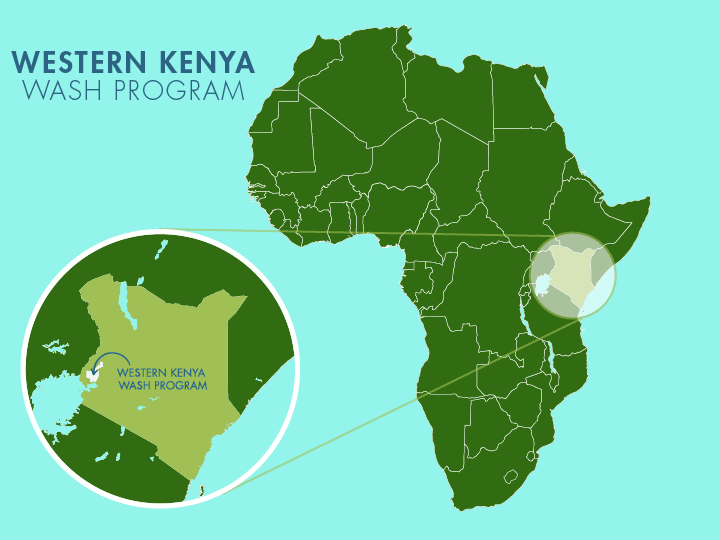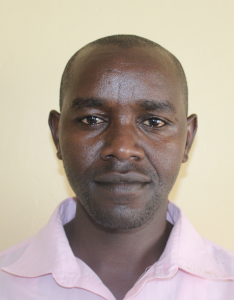The 350 community members in the Kitui Community all rely on the Mmboto Spring, though it is far from reliable. The spring is overcrowded, leaving many without enough water to collect. Often, community members must resort to filling their jerrycans from a stream whose water quality has been proven to be hazardous instead.

Community members walking to collect water.
"Though the spring is partially protected, community members are always trying their best to ensure that it is clean and no litter is deposited at the collection area. The surrounding area around the drainage channel is badly neglected, with water soaking the soil, forming mud that makes the area stuffy, therefore raising sanitation issues," Field Officer Wilson Kipchoge shared as he described the partially protected spring.
Their last resort, the local stream, is a pathway for disease and waste.

The contaminated stream.
Wilson added, "The water from this source is always disturbed by activities that are carried out along the flow channel, which contribute to regular changes in color, taste, and smell. In most cases, the water appears yellow, brown, and milky due to contamination, leading to it being unsafe for consumption. Smell is inevitable due to the fact that the whole water system is a carriage channel through which every solid waste is washed downstream, creating [a] high level of smell in the water."
Wilson didn't mince words, when he said, "Stream water has become a real threat to the health of community members, because the water is extremely and very highly contaminated, leading to cases of diarrhea and typhoid, that is putting the lives of small children who are ignorant of the underlying dangers of using the water from such [a] source at risk."

Andrew.
Children like 13-year-old Andrew are all too familiar with the consequences of their community's water crisis.
"I always fear getting sick from drinking water from this water point, especially during [the] rainy season, which leads to contamination from surface runoff. Fetching water sometimes takes [a] long [time] due to congestion at the water point, caused by crowding when every member of the community wants to fetch water at the same time," Andrew explained.
Fear of illness isn't the only debilitating effect of a broken-down waterpoint. Andrew's education suffers as well.

Andrew at the unprotected spring.
He shared, "The exercise of fetching water is time-consuming and tiresome. I sometimes wish that fetching water could only happen during weekends when I do not need to go to school, but this wish is of no value, since water is required every moment of the day. Therefore, I have to bear with the reality, and ensure that I balance my school time and fetching of water. With this concern, I sometimes report to school late and miss morning pre-lesson classes, which affects my overall score performance."
Repairing Andrew's spring is the foundation for a better future. With a reliable water source and a chlorine dispenser, his health can be almost guaranteed. His dreams of excelling in school and becoming a pilot are more attainable in a community where clean water is readily available.
"My plan for the future is to be a pilot and be able to fly to different countries of the world, and get money from the salary to help improve the living standards of my family," Andrew concluded.
Steps Toward a Solution
Our technical experts worked with the local community to identify the most effective solution to their water crisis. They decided to safeguard the existing flowing spring.
Spring Protection
Springs are natural water sources that originate from deep underground. As water travels through various layers of the earth, it undergoes a natural filtration process, making it cleaner and safer to drink. To protect these spring sources from contamination, we construct a waterproof cement structure around layers of clay, stone, and soil. This design channels the spring water through a discharge pipe, facilitating easier, faster, and cleaner water collection.
Chlorine Dispenser
As an extra measure towards water quality safety, uniquely engineered chlorine dispensers are installed at all of our spring protection projects so community members can treat their water with pre-measured doses of chlorine. The chlorine treats any possible contamination and stays active for two to three days, ensuring water stays safe to use even when stored at home. Chlorine delivery and maintenance of the dispensers are part of our ongoing community support.
Community Education & Ownership
Hygiene and sanitation training are integral to our water projects. Training is tailored to each community's specific needs and includes key topics such as proper water handling, improved hygiene practices, disease transmission prevention, and care of the new water point. Safe water and improved hygiene habits foster a healthier future for everyone in the community. Encouraged and supported by the guidance of our team, a water user committee representative of the community's diverse members assumes responsibility for maintaining the water point, often gathering fees to ensure its upkeep.

 Protected Spring
Protected Spring
 Rehabilitation Project
Rehabilitation Project


















